- Home
- Arthur C. Clarke
The Ghost from the Grand Banks (Arthur C. Clarke Collection) Page 14
The Ghost from the Grand Banks (Arthur C. Clarke Collection) Read online
Page 14
“How do you spell that?”
“C-O-B-H.”
“Well, we’ll talk to the archbishops, or whoever, as well as the cardinals, just to cover all bases. But let me tell you what our engineers have cooked up. If it works, it will be a lot better than hydrazine. And it should even start Bluepeace shouting slogans for us.”
“That’ll be a nice change. In fact, a miracle.”
“Miracles are our business—didn’t you know?”
“What are the specs of this particular one?”
“First, we’re making our iceberg larger, to get more lift. As a result, we’ll only need about ten k-tons of extra buoyancy. We could go Parky’s route for that, and at first we were afraid we might have to. But there’s a neater—and cleaner—way of getting gas down there. Electrolysis. Splitting the water into oxygen and hydrogen.”
“That’s an old idea. Won’t it take enormous amounts of current? And what about the risk of an explosion?”
“Silly question, Donald. The gases will go to separate electrodes, and we’ll have a membrane to keep them apart. But you’re right about the current. Gigawatt-hours! But we’ve got them—when our nuclear subs have done their thing with the Peltier cooling elements, we’ll switch to electrolysis. May have to rent another boat, though—why are subs always called boats? I told you that the Brits and the French would like to get into the act, so that’s no problem.”
“Very elegant,” said Donald. “And I see what you mean about pleasing Bluepeace. Everyone’s in favor of oxygen.”
“Exactly—and when we vent the balloons on the way up, the whole world will breathe a little easier. At least, that’s what P.R. will be saying.”
“And the hydrogen will go straight up to the stratosphere without bothering anyone. Oh—what about the poor old ozone layer? Any danger of making more holes?”
“We’ve checked that, of course. Won’t be any worse off than it is now. Which, I admit, isn’t saying a great deal.”
“Would it make sense to bottle the gases on the way up? You’re starting with hundreds of tons of oxy-hydrogen, at four hundred atmospheres. That must be quite valuable; why throw it away?”
“Yes—we’ve even looked into that. It’s marginal—increased complexity, cost of shipping tanks, and so on. Might be worth a try on a test basis—and gives us a fall-back position if the environment lobby gets nasty again.”
“You’ve thought of everything, haven’t you?” said Donald with frank admiration.
Kato shook his head slowly.
“Our friend Bradley once told me: ‘When you’ve thought of everything—the sea will think of something else.’ Words of wisdom, and I’ve never forgotten them…. Must hang up now— Oh—give my love to Edith.”
OPERATIONS
32.
NOBODY HERE BUT US ROBOTS
Until the first decade of the new century, the great wreck and the debris surrounding it had remained virtually unchanged, though not untouched. Now, as 2010 approached, it was a hive of activity—or, rather, two hives, a thousand meters apart.
The framework of scaffolding around the bow section was almost complete, and the Mole had successfully laid twenty-five of the massive straps under the hull; there were only five to go. Most of the mud that had piled up around the prow when it drove into the seabed had been blasted away by powerful water jets, and the huge anchors were no longer half buried in silt.
More than twenty thousand tons of buoyancy had already been provided by as many cubic meters of packaged microspheres, strategically placed around the framework, and at the few places inside the wreck where the structure could safely take the strain. But Titanic had not stirred from her resting place—nor was she supposed to. Another ten thousand tons of lift would be needed to get her out of the mud, and to start her on the long climb to the surface.
As for the shattered stern—that had already disappeared inside a slowly accreting block of ice. The media were fond of quoting Hardy’s “In shadowy silent distance grew the Iceberg too”—even though the poet could never have imagined this application of his words.
The penultimate verse was also quoted widely, and equally out of context. Both the Parkinson and Nippon-Turner consortia were rather tired of being told that
They were bent
By paths coincident
On being anon twin halves of one august event
They hoped that it would be “august”—but not, if they could possibly help it, coincident.
Virtually all the work on both portions of the wreck had been carried out by remote control from the surface; only in critical cases were human beings actually required on the site. During the past decade, underwater robot technology had been pushed far beyond even the remarkable achievements of the previous century’s offshore oil operations. The payoff would be enormous—although, as Rupert Parkinson often wryly remarked, most of it would go to other people.
There had, of course, been problems, mishaps—even accidents, though none involving loss of life. During one severe winter storm, Explorer had been forced to abandon station, much to the disgust of her captain, who considered this a professional insult. His vomitous passengers did not altogether appreciate his point of view.
Even this display of North Atlantic ferocity, however, had not interrupted operations on the stern. Two hundred meters down, the demobilized nuclear submarines, now rechristened, after a pioneer oceanographer and a famous shipbuilder, Matthew Fontaine Maury and Peter the Great, were scarcely aware of the storm. Their reactors continued steadily pouring megawatt upon megawatt of low-voltage current down to the seabed—creating a rising column of warm water in the process, as heat was pumped out of the wreck.
This artificial upwelling had produced an unexpected bonus, by bringing to the surface nutrients that would otherwise have been trapped on the seabed. The resulting plankton bloom was much appreciated by the local fish population, and the last cod harvest had been a record one. The government of Newfoundland had formally requested the submarines to remain on station, even when they had fulfilled their contract with Nippon-Turner.
Quite apart from all this activity off the Grand Banks, a great deal of money and effort was being expended thousands of kilometers away. Down in Florida, not far from the launchpads that had seen men leave for the Moon—and were now seeing them prepare to go to Mars—dredging and construction for the Titanic Underwater Museum was well under way. And on the other side of the globe, Tokyo-on-Sea was preparing an even more elaborate display, with transparent viewing corridors for visitors and, of course, continuous performances of what was hoped would be a truly spectacular movie.
Vast sums of money were also being gambled elsewhere—especially in the land once more called Russia. Thanks to Peter the Great, share dealings in Titanic spinoff companies were very popular on the Moscow Stock Exchange.
33.
SOLAR MAX
“Another of my monomanias,” said Franz Zwicker, “is the sunspot cycle. Especially the current one.”
“What’s particular about it?” asked Bradley, as they walked down to the lab together.
“First of all, it will peak in—you guessed it!—2012. It’s already way past the 1990 maximum, and getting close to the 2001 record.”
“So?”
“Well, between you and me, I’m scared. So many cranks have tried to correlate events with the eleven-year cycle—which isn’t always eleven years anyway!—that sunspot counting sometimes gets classed with astrology. But there’s no doubt that the sun influences practically everything on Earth. I’m sure it’s responsible for the weird weather we’ve been having during the last quarter century. To some extent, anyway; we can’t put all the blame on the human race, much as Bluepeace and Company would like to.”
“I thought you were supposed to be on their side!”
“Only on Mondays, Wednesdays, and Fridays. The rest of the week I keep a wary eye on Mother Nature. And the weather patterns aren’t the only abnormality. Seismic activity
seems to be increasing. Look at California. Why do people still build houses in San Francisco? Wasn’t 2002 bad enough? And we’re still waiting for the Big One….”
Jason felt privileged to share the scientist’s thoughts; the two men, so different in background and character, had grown to respect each other.
“And there’s something else, that occasionally gives me nightmares. Deep-water blowouts—perhaps triggered by earthquakes. Or even by man.”
“I’ve known several. A big one in ’98, in the Louisiana Field. Wrote off a whole rig.”
“Oh, that was just a mild burp! I’m talking about the real thing—like that crater the Shell Oil scientists found two kilometers down in the Gulf, back in the eighties. Imagine the explosion that caused that—three million tons of seabed scooped out! Equivalent to a good-sized atomic bomb.”
“And you think that could happen again?”
“I know it will—but not when and where. I keep warning the people up at Hibernia that they’re tickling the dragon’s tail. If Tommy Gold is right—and he was right about neutron stars, even if he struck out on moondust and the Steady State!—we’ve barely scratched the Earth’s crust. Everything we’ve tapped so far is just minor leakage from the real hydrocarbon reservoirs, ten or more kilometers down.”
“Some leak! It’s been running our civilization for the last couple of centuries.”
“Did you say running—or ruining? Well, here’s your prize pupil. How’s class going?”
J.J. lay in a transporter cradle, very much a fish out of water. It was attached to a bank of computers by what seemed to Bradley to be an absurdly thin cable. Having grown up with copper wiring, he had never become quite accustomed to the fiber-optic revolution.
Nothing seemed to be happening; the technician in charge hastily concealed the microbook she was viewing, and quickly scanned the monitor display.
“Everything fine, Doctor,” she said cheerfully. “Just verifying the expert system data bases.”
That’s part of me, thought Jason. He had spent hours in dive simulators, while computer programmers tried to codify and record his hard-won skills—the very essence of veteran ocean engineer J. Bradley. He was beginning to feel more and more that, at least in a psychological sense, J.J. was becoming a surrogate son.
That feeling became strongest when they were engaged in a direct conversation. It was an old joke in the trade that divers had a vocabulary of only a couple of hundred words—which was all they needed for their work. J.J. had enough artificial intelligence to exceed this by a comfortable margin.
The lab had hoped to surprise Jason by using his voice as a template for J.J.’s speech synthesizer, but his reaction had been disappointing. The pranksters had forgotten that few people can recognize their own recorded voice, especially if it is uttering sentences that they have never spoken themselves. Jason had not caught on until he had noticed the grinning faces around him.
“Any reason, Anne, why we can’t start the wet run on schedule?” Zwicker asked.
“No, Doctor. The emergency recall algorithm still doesn’t seem to be working properly, but of course we won’t need it for the tests.”
Although the sound transducers were not designed to function in air, Jason could not resist a few words with Junior.
“Hello, J.J. Can you hear me?”
“I can hear you.”
The words were badly distorted, but quite recognizable. Underwater, the speech quality would be much better.
“Do you recognize me?”
There was a long silence. Then J.J. replied.
“Question not understood.”
“Walk closer, Mr. Bradley,” the technician advised. “He’s very deaf out of water.”
“Do you recognize me?”
“Yes. You are John Maxwell.”
“Back to the drawing board,” muttered Zwicker.
“And who,” asked Bradley, more amused than annoyed, “is John Maxwell?”
The girl was quite embarrassed.
“He’s section chief, Voice Recognition. But there’s no problem—this isn’t a fair test. Underwater he’ll know you from half a kilometer away.”
“I hope so. Goodbye, J.J. See you later—when you’re not quite so deaf. Let’s see if Deep Jeep is in better shape.”
Deep Jeep was the lab’s other main project, in some ways almost equally demanding. The reaction of most visitors at first viewing was: “Is it a submarine or a diving suit?” And the answer was always, “Both.”
Servicing and operating three-man deep submersibles like Marvin was an expensive business: a single dive could cost a hundred thousand dollars. But there were many occasions when a much less elaborate, one-man vehicle would be adequate.
Jason Bradley’s secret ambition was already well known to the entire lab. He hoped Deep Jeep would be ready in time to take him down to Titanic—while the wreck still lay on the ocean floor.
34.
STORM
It would be decades before the meteorologists could prove that the great storm of 2010 was one of the series that had begun in the 1980s, heralding the climatic changes of the next millennium. Before it exhausted its energies battering against the western ramparts of the Alps, Gloria did twenty billion dollars’ worth of damage and took more than a thousand lives.
The weather satellites, of course, gave a few hours’ warning—otherwise the death toll would have been even greater. But, inevitably, there were many who did not hear the forecasts, or failed to take them seriously. Especially in Ireland, which was the first to receive the hammerblow from the heavens.
Donald and Edith Craig were editing the latest footage from Operation DEEP FREEZE when Gloria hit Conroy Castle. They heard and felt nothing deep inside the massive walls—not even the crash when the camera obscura was swept off the battlements.
Ada now cheerfully admitted that she was hopeless at pure mathematics—the kind which, in G. H. Hardy’s famous toast, would never be of any use to anyone. Unknown to him—because the secrets of ENIGMA’S code-breaking were not revealed until decades later—Hardy had been proved spectacularly wrong during his own lifetime. In the hands of Alan Turing and his colleagues, even something as abstract as number theory could win a war.
Most of calculus and higher trigonometry, and virtually all of symbolic logic, were closed books to Ada. She simply wasn’t interested; her heart was in geometry and the properties of space. Already she was trifling with five dimensions, four having proved too simple. Like Newton, much of the time she was “sailing strange seas of thought—alone.”
But today, she was back in ordinary three-space, thanks to the present that “Uncle” Bradley had just sent her. Thirty years after its first appearance, Rubik’s Cube had made a comeback—in a far more deadly mutation.
Because it was a purely mechanical device, the original cube had one weakness, for which its addicts were sincerely thankful. Unlike all their neighbors, the six center squares on each face were fixed. The other forty-eight squares could orbit around them, to create a possible 43252 00327 44898 56000 distinct patterns.
The Mark II had no such limitations; all the fifty-four squares were capable of movement, so there were no fixed centers to give reference points to its maddened manipulators. Only the development of microchips and liquid crystal displays had made such a prodigy possible; nothing really moved, but the multicolored squares could be dragged around the face of the cube merely by touching them with a fingertip.
Relaxing in her little boat with Lady, engrossed with her new toy, Ada had been slow to notice the darkening sky. The storm was almost upon her before she started the electric motor and headed for shelter. That there could be any danger never occurred to her; after all, Lake Mandelbrot was only three feet deep. But she disliked getting wet—and Lady hated it.
By the time she had reached the lake’s first western lobe, the roar of the gale was almost deafening. Ada was thrilled; this was really exciting! But Lady was terrified, and tried to hide herself un
der the seat.
Heading down the Spike, between the avenue of cypresses, she was partly sheltered from the full fury of the gale. But for the first time, she became alarmed; the great trees on either side were swaying back and forth like reeds.
She was only a dozen meters from the safety of the boathouse, far into the Utter West of the M-Set and nearing the infinity border post at minus 1.999, when Patrick O’Brian’s fears about the transplanted cypress trees were tragically fulfilled.
35.
ARTIFACT
One of the most moving archaeological discoveries ever made took place in Israel in 1976, during a series of excavations carried out by scientists from the Hebrew University and the French Center for Prehistoric Research in Jerusalem.
At a 10,000-year-old campsite, they uncovered the skeleton of a child, one hand pressed against its cheek. In that hand is another tiny skeleton: that of a puppy about five months old.
This is the earliest example we know of man and dog sharing the same grave. There must be many, many later ones.
(From Friends of Man by Roger Caras. Simon & Schuster, 2001.)
“You may be interested to know,” said Dr. Jafferjee with that clinical detachment which Donald found annoying (though how else could psychiatrists stay sane?) “that Edith’s case isn’t unique. Ever since the M-Set was discovered in 1980, people have managed to become obsessed with it. Usually they are computer hackers, whose grip on reality is often rather tenuous. There are no less than sixty-three examples of Mandelmania now in the data banks.”
“And is there any cure?”
Dr. Jafferjee frowned. “Cure” was a word he seldom used. “Adjustment” was the term he preferred.
“Let’s say that in eighty percent of the cases, the subject has been able to resume an—ah—normal life, sometimes with the help of medication or electronic implants. Quite an encouraging figure.”

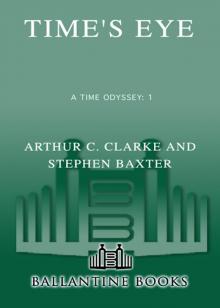 Time's Eye
Time's Eye The Sentinel
The Sentinel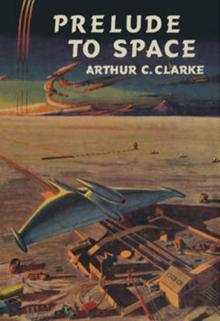 Prelude to Space
Prelude to Space Earthlight (Arthur C. Clarke Collection)
Earthlight (Arthur C. Clarke Collection)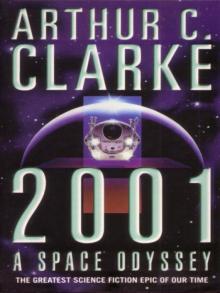 2001: A Space Odyssey
2001: A Space Odyssey Against the Fall of Night
Against the Fall of Night Glide Path
Glide Path The Lost Worlds of 2001
The Lost Worlds of 2001 The Trigger
The Trigger Reach for Tomorrow
Reach for Tomorrow Islands in the Sky
Islands in the Sky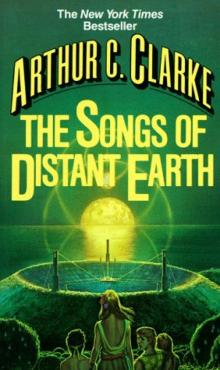 The Songs of Distant Earth
The Songs of Distant Earth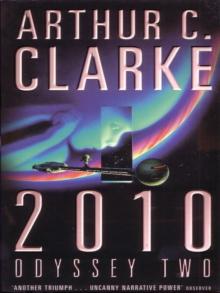 2010: Odyssey Two
2010: Odyssey Two Childhood's End
Childhood's End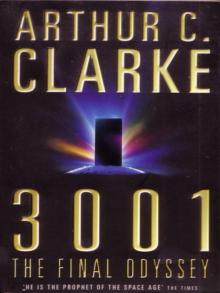 3001: The Final Odyssey
3001: The Final Odyssey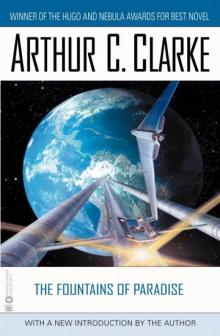 The Fountains of Paradise
The Fountains of Paradise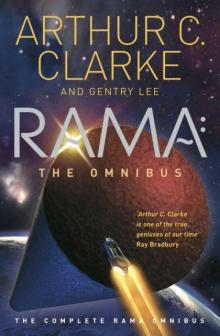 Rama: The Omnibus
Rama: The Omnibus The Hammer of God
The Hammer of God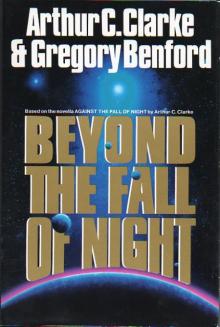 Beyond the Fall of Night
Beyond the Fall of Night Tales From Planet Earth
Tales From Planet Earth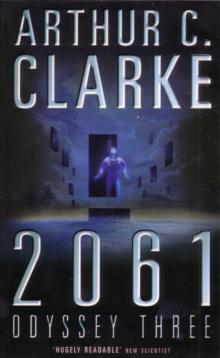 2061: Odyssey Three
2061: Odyssey Three Tales From the White Hart
Tales From the White Hart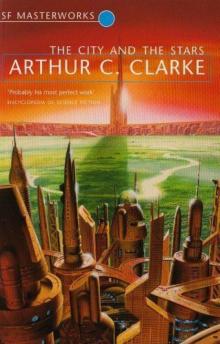 The City and the Stars/The Sands of Mars
The City and the Stars/The Sands of Mars The Star
The Star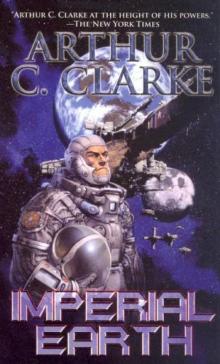 Imperial Earth
Imperial Earth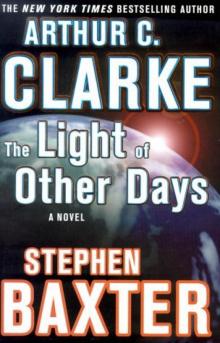 The Light of Other Days
The Light of Other Days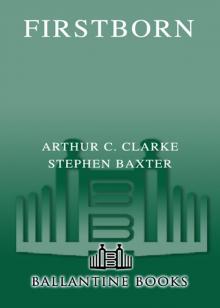 Firstborn
Firstborn The Other Side of the Sky
The Other Side of the Sky Cradle
Cradle The Wind From the Sun
The Wind From the Sun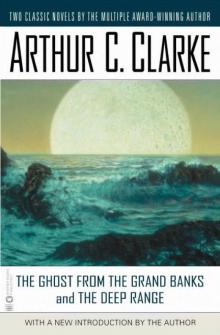 The Ghost From the Grand Banks and the Deep Range
The Ghost From the Grand Banks and the Deep Range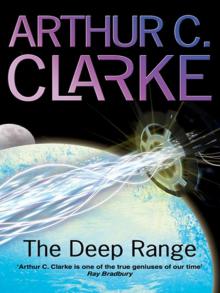 The Deep Range
The Deep Range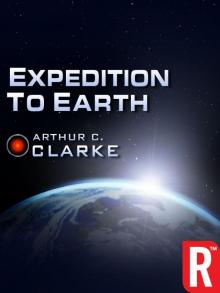 Expedition to Earth
Expedition to Earth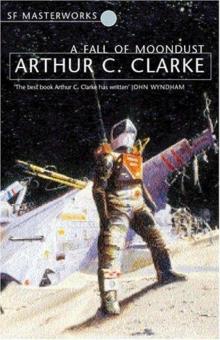 A Fall of Moondust
A Fall of Moondust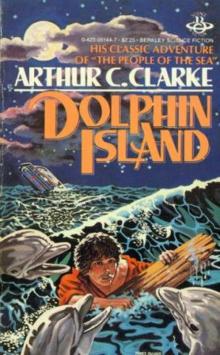 Dolphin Island (Arthur C. Clarke Collection)
Dolphin Island (Arthur C. Clarke Collection) Richter 10
Richter 10 The City and the Stars
The City and the Stars Tales of Ten Worlds
Tales of Ten Worlds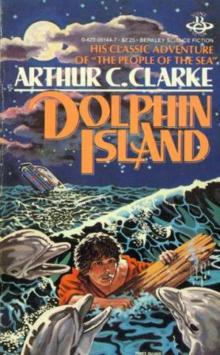 Dolphin Island
Dolphin Island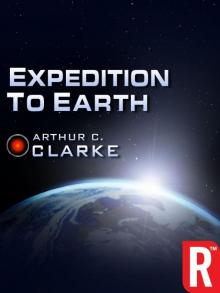 Expedition to Earth (Arthur C. Clarke Collection: Short Stories)
Expedition to Earth (Arthur C. Clarke Collection: Short Stories)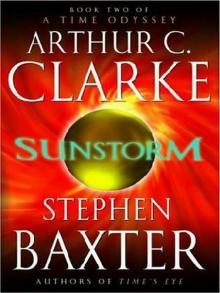 Sunstorm
Sunstorm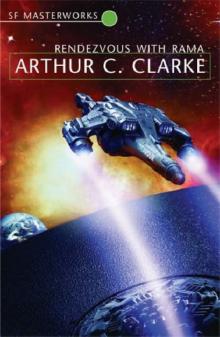 Rendezvous with Rama
Rendezvous with Rama The Collected Stories of Arthur C. Clarke
The Collected Stories of Arthur C. Clarke Trouble with the Natives
Trouble with the Natives Rama Revealed r-4
Rama Revealed r-4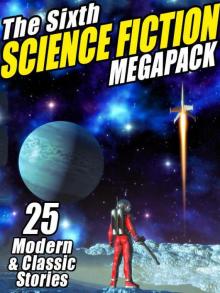 The Sixth Science Fiction Megapack
The Sixth Science Fiction Megapack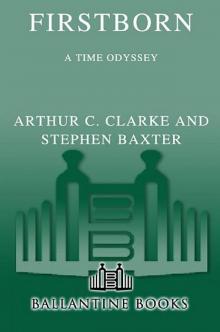 Firstborn to-3
Firstborn to-3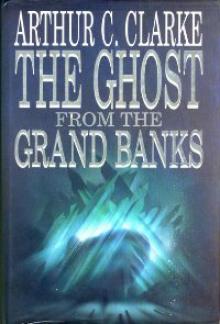 The Ghost from the Grand Banks
The Ghost from the Grand Banks Into the Comet
Into the Comet The Fires Within
The Fires Within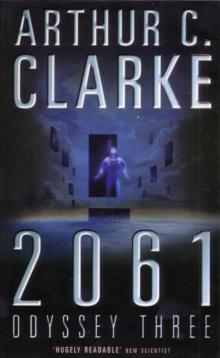 2061: Odyssey 3
2061: Odyssey 3 The Ninth Science Fiction Megapack
The Ninth Science Fiction Megapack The Coast of Coral
The Coast of Coral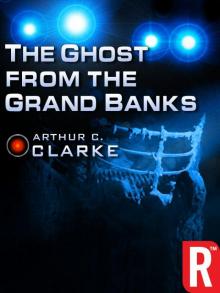 The Ghost from the Grand Banks (Arthur C. Clarke Collection)
The Ghost from the Grand Banks (Arthur C. Clarke Collection) The Space Trilogy
The Space Trilogy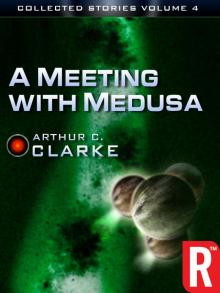 A Meeting With Medusa
A Meeting With Medusa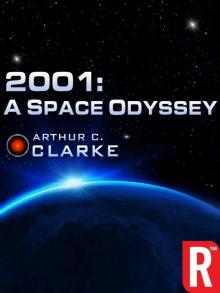 2001: A Space Odyssey (Arthur C. Clarke Collection: The Odyssey)
2001: A Space Odyssey (Arthur C. Clarke Collection: The Odyssey) Islands in the Sky (Arthur C. Clarke Collection)
Islands in the Sky (Arthur C. Clarke Collection)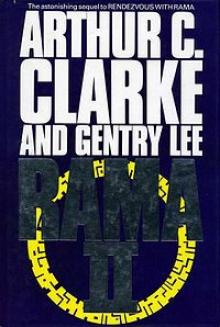 Rama II r-2
Rama II r-2 Glide Path (Arthur C. Clarke Collection)
Glide Path (Arthur C. Clarke Collection)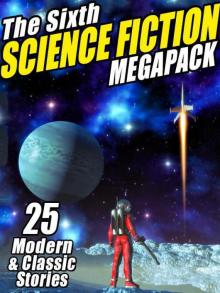 The Sixth Science Fiction Megapack: 25 Classic and Modern Science Fiction Stories
The Sixth Science Fiction Megapack: 25 Classic and Modern Science Fiction Stories Tales from the White Hart (Arthur C. Clarke Collection: Short Stories)
Tales from the White Hart (Arthur C. Clarke Collection: Short Stories) The Reluctant Orchid
The Reluctant Orchid